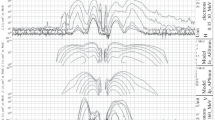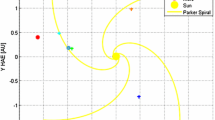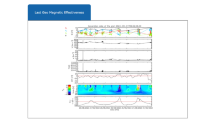Abstract
Within the framework of the Moscow University space project SOZVEZDIE-270, a constellation of cubesat nano-satellites with a set of instruments is being deployed, which, among other goals, provides monitoring of the near-Earth space radiation environment, control of the geo- and heliophysical conditions. Along with the space constellation, a network of ground receiving stations is also being created. During the project implementation, 11 spacecraft of the cubesat format have been launched to date. Currently, there are 6 such spacecraft operating in near-Earth orbit, which transmit scientific and telemetric data. During 2023–2024 it is planned to launch at least 8 more such satellites into low circular polar orbits. Multi-satellite constellation has been implemented, which makes it possible to carry out simultaneous measurements of particle and quantum fluxes using the same type of instruments at different points in the near-Earth space. Such measurements provide unique information about the sub-relativistic electron flux dynamics, including variations due to precipitation, which is of great importance for understanding the mechanisms of trapped and quasi-trapped electron acceleration and losses.
Access this chapter
Tax calculation will be finalised at checkout
Purchases are for personal use only
Similar content being viewed by others
References
Getzelev, I.V., Gusev, A.A., Darchieva, L.A., et al.: The model of space-energy distribution of trapped particle (electron and proton) fluxes inthe Earth radiation belts. MSU, Moscow (1991). (in Russian)
Li, X., et al.: Multi satellite observations of the outer zone electron variation during the November 3–4, 1993, magnetic storm. J. Geophys. Res. 102(A7), 14123–14140 (1997)
Baker, D.N., et al.: A strong CME-related magnetic cloud interaction with the Earth’s magnetosphere: ISTP observations of rapid relativistic electron acceleration on May 15, 1997. Geophys. Res. Lett. 25(15), 2975–2978 (1998)
O’Brien, T., McPherron, R., Sornette, D., Reeves, G., Friedel, R., Singer, H.: Which magnetic storms produce relativistic electrons at geosynchronous orbit? J. Geophys. Res. 106(A8), 15533–15544 (2001)
Green, J.C., Kivelson, M.G.: Relativistic electrons in the outer radiation belt: differentiating between acceleration mechanisms. J. Geophys. Res. 109, A03213 (2004). https://doi.org/10.1029/2003JA010153
Trakhtengerts, VYu., Rycroft, M.J.: Whistle and Alfven Mode Cyclotron Masers in Space. Cambridge University Press, Cambridge (2008)
Ukhorskiy, A.Y., Anderson, B.J., Brandt, P.C., Tsyganenko, N.A.: Storm time evolution of the outer radiation belt: transport and losses. J. Geophys. Res. 111, A11S03 (2006) https://doi.org/10.1029/2006JA011690
Kim, K.-C., et al.: Numerical calculations of relativistic electron drift loss effect. J. Geophys. Res. 113, A09212 (2008). https://doi.org/10.1029/2007JA013011
Ohtani, S., Miyoshi, Y., Singer, H.J., Weygand, J.M.: On the loss of relativistic electrons at geosynchronous altitude: Its dependence on magnetic configurations and external conditions. J. Geophys. Res. 114, A01202 (2009). https://doi.org/10.1029/2008JA013391
McDonald, W.H., Walt, M.: Distribution function of magnetically confined electrons in a scattering atmosphere. Ann. Phys. 15, 44–48 (1961)
Tverskoy, B.A.: The Earth’s radiation belt theory. In: Proceedings of 9th ICRC, London, vol. 1, pp. 546–547 (1965)
Horne, R.B., Thorne, R.M.: Relativistic electron acceleration and precipitation during resonant interactions with whistler-mode chorus. Geophys. Res. Lett. 30(10), 1527 (2003). https://doi.org/10.1029/2003GL016973
Summers, D., Thorne, R.M.: Relativistic electron pitch-angle scattering by electromagnetic ion cyclotron waves during geomagnetic storms. J. Geophys. Res. 108, 1143 (2003). https://doi.org/10.1029/2002JA009489
Millan, R.M., Lin, R.P., Smith, D.M., McCarthy, M.P.: Observation of relativistic electron precipitation during a rapid decrease of trapped relativistic electron flux. Geophys. Res. Lett. 34, L10101 (2007). https://doi.org/10.1029/2006GL028653
Thorne, R.M., et al.: Rapid local acceleration of relativistic radiation-belt electrons by magnetospheric chorus. Nature 504, 411–414 (2013). https://doi.org/10.1038/nature12889
Li, W., et al.: Evidence of stronger pitch angle scattering loss caused by oblique whistler-mode waves as compared with quasi-parallelwaves. Geophys. Res. Lett. 41, 6063–6070 (2014). https://doi.org/10.1002/2014GL061260
Onsager, T.G., Rostoker, G., Reeves, H.-J., Obara, G.D., Singer, H.J., Smithtro, C.: Radiation belt electron flux dropouts: local time? Radial and particle-energy dependence. J. Geophys. Res. 107 (2002). https://doi.org/10.1029/2001JA000187
Sadovnichii, V.A., Panasyuk, M.I., Yashin, I.V., et al.: Investigations of the space environment aboard the Universitetsky-Tat’yana and Universitetsky-Tat’yana-2 microsatellites. Solar Syst. Res. 45(1), 3–29 (2011)
Panasyuk, M.I., et al.: Experiment on the Vernov satellite: transient energetic processes in the Earth’s atmosphere and magnetosphere. Part I: description of the experiment. Cosmic Res. 54(4), 261–269 (2016). https://doi.org/10.1134/S0010952516040043
Panasyuk, M.I., et al.: Experiment on the Vernov satellite: transient energetic processes in the Earth’s atmosphere and magnetosphere. Part II. First results. Cosmic Res. 54(5), 343–350 (2016). https://doi.org/10.1134/S0010952516050051
Sadovnichii, V.A., Panasyuk, M.A., Amelyushkin, A.M., et al.: Lomonosov” satellite—space observatory to study extreme phenomena in space. Space Sci. Rev. 212(3–4), 1705–1738 (2017). https://doi.org/10.1007/s11214-017-0425-x
Bogomolov, V.V., et al.: A first experience of space radiation monitoring in the multi-satellite experiment of Moscow University in the framework of the Universat-SOCRAT project. Moscow Univ. Phys. Bull. 73(6), 676–683 (2020). https://doi.org/10.3103/S0027134920060089
Prokhorov, M.I., et al.: Analysis of fast variations in electron fluxes in the gap region using the normalized range method based on measurement data on the SiriusSat-1 satellite. Cosmic Res. 60(4), 241–253 (2022). https://doi.org/10.1134/S0010952522040062
Bogomolov, A.V., Bogomolov, V.V., Iyudin, A.F.: Space weather effects from observations by Moscow University Cubesat constellation. Universe 8, 282 (2022). https://doi.org/10.3390/universe8050282
Osedlo, V.I., Antonyuk, G.I., Bengin, V.V., et al.: Educational project of Moscow university “Monitor” based on cubsat constellation. In: Fourth Russian Symposium on Nano-Satellites, RusNanoSat-2021, Samara, 28–30, June 2021. S.P. Korolev Samara National Research University (2021). (in Russian). http://volgaspace.org/rusnanosat/
Bogomolov, V.V., Antonyuk, G.I., Bengin, V.V., et al.: Scientific and educational project “Monitor” based on satellites of cubsat format. In: First International Conference on Space Education “Road to Space”, Moscow, 5–8 October 2021, pp. 53–54. Institute of Space Research, RAS (2021). (in Russian). https://roadtospace.cosmos.ru/docs/2021/RoadToSpace-AbstractBook-2021-v2.pdf
Acknowledgements
This work was done with the support of MSU Program of Development, Project №23-Ш01-02.
Author information
Authors and Affiliations
Corresponding author
Editor information
Editors and Affiliations
Rights and permissions
Copyright information
© 2023 The Author(s), under exclusive license to Springer Nature Switzerland AG
About this paper
Cite this paper
Svertilov, S. et al. (2023). Observations of Space Weather Effects from the Moscow University Nano-satellite Constellation Sozvezdie-270. In: Dmitriev, A., Lichtenberger, J., Mandrikova, O., Nahayo, E. (eds) Solar-Terrestrial Relations and Physics of Earthquake Precursors. STRPEP 2023. Springer Proceedings in Earth and Environmental Sciences. Springer, Cham. https://doi.org/10.1007/978-3-031-50248-4_21
Download citation
DOI: https://doi.org/10.1007/978-3-031-50248-4_21
Published:
Publisher Name: Springer, Cham
Print ISBN: 978-3-031-50247-7
Online ISBN: 978-3-031-50248-4
eBook Packages: Physics and Astronomy (R0)Reference Module Earth and Environmental Sciences




